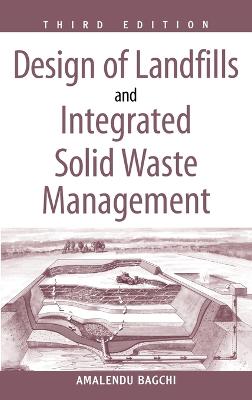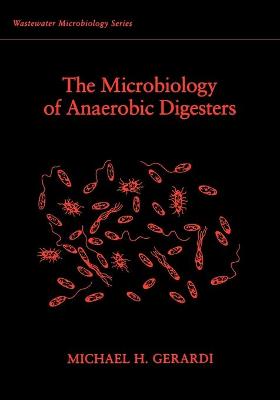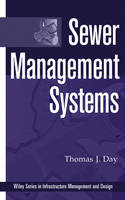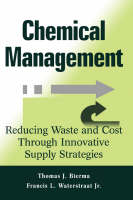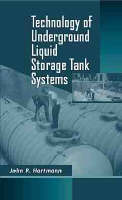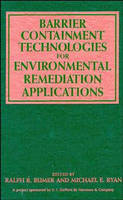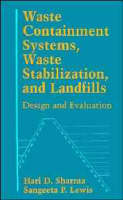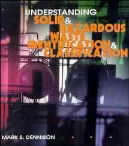Geoenvironmental Engineering
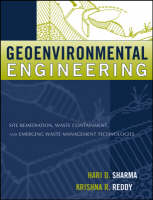 -15%
portes grátis
-15%
portes grátis
Geoenvironmental Engineering
Site Remediation, Waste Containment, and Emerging Waste Management Technologies
Sharma, Hari D.; Reddy, Krishna R.
John Wiley & Sons Inc
06/2004
992
Dura
Inglês
9780471215998
15 a 20 dias
1856
1. INTRODUCTION.
1.1 Emergence of Geoenvironmental Engineering.
1.2 Types of Geoenvironmental Problems.
1.3 Book Organization.
1.4 Summary.
Questions/Problems.
References.
2. RELEVANT ENVIRONMENTAL LAWS AND REGULATIONS.
2.1 Introduction.
2.2 Development of Laws and Regulations.
2.3 Federal Environmental Laws and Regulations.
2.4 State and Local Laws and Regulations.
2.5 Impact of Regulations on Geoenvironmental Practice.
2.6 Summary.
Questions/Problems.
References.
3. CHEMICAL BACKGROUND.
3.1 Introduction.
3.2 Toxic Chemicals.
3.3 Inorganic Chemistry Background.
3.4 Organic Chemistry Background.
3.5 Nuclear Chemistry Background.
3.6 Chemical Analysis Methods.
3.7 Summary.
Questions/Problems.
References.
4. COMPOSITION OF SOILS.
4.1 Introduction.
4.2 Soil Formation.
4.3 Soil Composition.
4.4 Soil Fabric.
4.5 Summary.
Questions/Problems.
References.
5. SOIL PROPERTIES.
5.1 Introduction.
5.2 Geotechnical Properties.
5.3 Chemical Properties.
5.4 Summary.
Questions/Problems.
References.
6. GEOCHEMISTRY BACKGROUND.
6.1 Introduction.
6.2 Inorganic Geochemistry.
6.3 Organic Geochemistry.
6.4 Summary.
Questions/Problems.
References.
7. GROUNDWATER FLOW.
7.1 Introduction.
7.2 Hydrologic Cycle and Groundwater.
7.3 Aquifer, Aquiclude, and Aquitard.
7.4 Hydraulic Head and Aquifer Properties.
7.5 Groundwater Flow in Aquifers.
7.6 One-Dimensional Steady Flow.
7.7 Flow Toward a Pumping Well.
7.8 Pumping and Slug Testing.
7.9 Two- and Three-Dimensional Groundwater Flow.
7.10 Summary.
Questions/Problems.
References.
8. CONTAMINANT TRANSPORT AND FATE.
8.1 Introduction.
8.2 Transport Processes.
8.3 Chemical Mass Transfer Processes.
8.4 Biological Process (Biodegradation).
8.5 Contaminant Transport and Fate Modeling.
8.6 Applications.
8.7 Summary.
Questions/Problems.
References.
PART II: REMEDIATION TECHNOLOGIES.
9. SUBSURFACE CONTAMINATION: SOURCES, CONTAMINANTS, REGULATIONS, AND REMEDIAL APPROACH.
9.1 Introduction.
9.2 Sources of Contamination.
9.3 Types of Contaminants.
9.4 Relevant Regulations.
9.5 Other Considerations.
9.6 Remediation Approach.
9.7 Summary.
Questions/Problems.
References.
10. CONTAMINATED SITE CHARACTERIZATION.
10.1 Introduction.
10.2 General Methodology.
10.3 Preliminary Site Assessment.
10.4 Exploratory Site Investigation.
10.5 Detailed Site Investigation.
10.6 Expedited or Accelerated Site Characterization.
10.7 Summary.
Questions/Problems.
References.
11. RISK ASSESSMENT AND REMEDIAL STRATEGY.
11.1 Introduction.
11.2 Risk Assessment Procedures.
11.3 USEPA Procedure.
11.4 ASTM Procedure.
11.5 Other Risk Assessment Methods.
11.6 Remedial Strategy.
Questions/Problems.
References.
12. IN-SITU WASTE CONTAINMENT.
12.1 Introduction.
12.2 Vertical Barriers.
12.3 Bottom Barriers.
12.4 Surface Caps or Covers.
12.5 Groundwater Pumping Systems.
12.6 Subsurface Drains.
12.7 Summary.
Questions/Problems.
References.
13. SOIL REMEDIATION TECHNOLOGIES.
13.1 Introduction.
13.2 Soil Vapor Extraction.
13.3 Soil Washing.
13.4 Stabilization and Solidification.
13.5 Electrokinetic Remediation.
13.6 Thermal Desorption.
13.7 Vitrification.
13.8 Bioremediation.
13.9 Phytoremediation.
13.10 Soil Fracturing.
13.11 Summary.
Questions/Problems.
References.
14. GROUNDWATER REMEDIATION TECHNOLOGIES.
14.1 Introduction.
14.2 Pump and Treat.
14.3 In-Situ Flushing.
14.4 Permeable Reactive Barriers.
14.5 In-Situ Air Sparging.
14.6 Monitored Natural Attenuation.
14.7 Bioremediation.
14.8 Summary.
Questions/Problems.
References.
PART III LANDFILLS AND SURFACE IMPOUNDMENTS.
15. SOURCES AND CHARACTERISTICS OF WASTES 605
15.1 Introduction.
15.2 Sources of Wastes.
15.3 Classification of Wastes.
15.4 Waste Characterization.
15.5 Environmental Concerns with Wastes.
15.6 Waste Management Strategies.
15.7 Engineered Waste Disposal Facilities.
15.8 Summary.
Questions/Problems.
References.
16. LANDFILL REGULATIONS, SITING, AND CONFIGURATIONS 635
16.1 Introduction.
16.2 Federal Regulations.
16.3 State and Local Regulations.
16.4 Siting Methodology.
16.5 Site Permit Application.
16.6 Landfill Configurations.
16.7 Summary.
Questions/Problems.
References.
17. WASTE CONTAINMENT LINER SYSTEMS.
17.1 Introduction.
17.2 Low-Permeability Soil Liners.
17.3 Geomembrane Liners.
17.4 Geotextiles.
17.5 Geosynthetic Clay Liners.
17.6 Geonets and Geocomposite Drains.
17.7 Geogrids.
17.8 Interface Strengths among Various Liner Components.
17.9 Manufacturing and Construction Quality Assurance.
17.10 Estimation of Leakage through Liner Systems.
17.11 Performance of Liners in Waste Containment Systems.
17.12 Summary.
Questions/Problems.
References.
18. LEACHATE COLLECTION AND REMOVAL SYSTEMS AND LINER DESIGN.
18.1 Introduction.
18.2 Design Criteria.
18.3 Leachate Generation and Management.
18.4 Containment System Liner Design.
18.5 Summary.
Questions/Problems.
References.
19. FINAL COVER SYSTEMS.
19.1 Introduction.
19.2 Purpose and Design Criteria.
19.3 Regulatory Minimum Requirements.
19.4 Design Procedure.
19.5 Summary.
Questions/Problems.
References.
20. GAS GENERATION AND MANAGEMENT.
20.1 Introduction.
20.2 Gas Generation Mechanisms.
20.3 Gas Characteristics.
20.4 Gas Production Rates.
20.5 Gas Migration.
20.6 Gas Collection Systems.
20.7 Gas Flaring and Energy Recovery.
20.8 Summary.
Questions/Problems.
References.
21. GROUNDWATER MONITORING.
21.1 Introduction.
21.2 Regulatory Requirements.
21.3 Groundwater Monitoring Systems.
21.4 Detection Monitoring Program.
21.5 Assessment Monitoring Program.
21.6 Corrective Action Program.
21.7 Summary.
Questions/Problems.
References.
22. SURFACE IMPOUNDMENTS.
22.1 Introduction.
22.2 Regulatory Setting.
22.3 Liner Systems.
22.4 Surface Impoundment Design.
22.5 Cover Design.
22.6 Closure and Postclosure Care.
22.7 Summary.
Questions/Problems.
References.
PART IV: EMERGING TECHNOLOGIES.
23. BENEFICIAL USE OF WASTE MATERIALS: RECYCLING.
23.1 Introduction.
23.2 Types and Evaluation of Waste Materials.
23.3 Fly Ash.
23.4 Blast Furnace Slag.
23.5 Foundry Sand.
23.6 Papermill Sludge.
23.7 Municipal Sludge.
23.8 Incinerator Ash (Sewage Sludge Ash).
23.9 Glass.
23.10 Plastics.
23.11 Scrap Tires.
23.12 Demolition Debris and Recycled Concrete.
23.13 Wood Wastes.
23.14 Summary.
Questions/Problems.
References.
24. END USES OF CLOSED LANDFILLS.
24.1 Introduction.
24.2 Various End Uses of Closed Landfills.
24.3 Design Considerations.
24.4 Case Studies.
24.5 Summary.
Questions/Problems.
References.
25. BIOREACTOR LANDFILLS.
25.1 Introduction.
25.2 Types and Advantages of Bioreactor Landfills.
25.3 Regulatory Issues.
25.4 Bioreactor Design.
25.5 Bioreactor Landfill Operations and Maintenance.
25.6 Case Studies.
25.7 Research Issues.
25.8 Summary.
Questions/Problems.
References.
26. SUBAQUATIC SEDIMENT WASTE: IN-SITU CAPPING.
26.1 Introduction.
26.2 Relevant Terminology and Definitions.
26.3 Site Evaluation.
26.4 Cap Design.
26.5 Construction and Monitoring.
26.6 Regulatory and Economic Considerations.
26.7 Case Studies.
26.8 Summary.
Questions/Problems.
References.
Index.
1. INTRODUCTION.
1.1 Emergence of Geoenvironmental Engineering.
1.2 Types of Geoenvironmental Problems.
1.3 Book Organization.
1.4 Summary.
Questions/Problems.
References.
2. RELEVANT ENVIRONMENTAL LAWS AND REGULATIONS.
2.1 Introduction.
2.2 Development of Laws and Regulations.
2.3 Federal Environmental Laws and Regulations.
2.4 State and Local Laws and Regulations.
2.5 Impact of Regulations on Geoenvironmental Practice.
2.6 Summary.
Questions/Problems.
References.
3. CHEMICAL BACKGROUND.
3.1 Introduction.
3.2 Toxic Chemicals.
3.3 Inorganic Chemistry Background.
3.4 Organic Chemistry Background.
3.5 Nuclear Chemistry Background.
3.6 Chemical Analysis Methods.
3.7 Summary.
Questions/Problems.
References.
4. COMPOSITION OF SOILS.
4.1 Introduction.
4.2 Soil Formation.
4.3 Soil Composition.
4.4 Soil Fabric.
4.5 Summary.
Questions/Problems.
References.
5. SOIL PROPERTIES.
5.1 Introduction.
5.2 Geotechnical Properties.
5.3 Chemical Properties.
5.4 Summary.
Questions/Problems.
References.
6. GEOCHEMISTRY BACKGROUND.
6.1 Introduction.
6.2 Inorganic Geochemistry.
6.3 Organic Geochemistry.
6.4 Summary.
Questions/Problems.
References.
7. GROUNDWATER FLOW.
7.1 Introduction.
7.2 Hydrologic Cycle and Groundwater.
7.3 Aquifer, Aquiclude, and Aquitard.
7.4 Hydraulic Head and Aquifer Properties.
7.5 Groundwater Flow in Aquifers.
7.6 One-Dimensional Steady Flow.
7.7 Flow Toward a Pumping Well.
7.8 Pumping and Slug Testing.
7.9 Two- and Three-Dimensional Groundwater Flow.
7.10 Summary.
Questions/Problems.
References.
8. CONTAMINANT TRANSPORT AND FATE.
8.1 Introduction.
8.2 Transport Processes.
8.3 Chemical Mass Transfer Processes.
8.4 Biological Process (Biodegradation).
8.5 Contaminant Transport and Fate Modeling.
8.6 Applications.
8.7 Summary.
Questions/Problems.
References.
PART II: REMEDIATION TECHNOLOGIES.
9. SUBSURFACE CONTAMINATION: SOURCES, CONTAMINANTS, REGULATIONS, AND REMEDIAL APPROACH.
9.1 Introduction.
9.2 Sources of Contamination.
9.3 Types of Contaminants.
9.4 Relevant Regulations.
9.5 Other Considerations.
9.6 Remediation Approach.
9.7 Summary.
Questions/Problems.
References.
10. CONTAMINATED SITE CHARACTERIZATION.
10.1 Introduction.
10.2 General Methodology.
10.3 Preliminary Site Assessment.
10.4 Exploratory Site Investigation.
10.5 Detailed Site Investigation.
10.6 Expedited or Accelerated Site Characterization.
10.7 Summary.
Questions/Problems.
References.
11. RISK ASSESSMENT AND REMEDIAL STRATEGY.
11.1 Introduction.
11.2 Risk Assessment Procedures.
11.3 USEPA Procedure.
11.4 ASTM Procedure.
11.5 Other Risk Assessment Methods.
11.6 Remedial Strategy.
Questions/Problems.
References.
12. IN-SITU WASTE CONTAINMENT.
12.1 Introduction.
12.2 Vertical Barriers.
12.3 Bottom Barriers.
12.4 Surface Caps or Covers.
12.5 Groundwater Pumping Systems.
12.6 Subsurface Drains.
12.7 Summary.
Questions/Problems.
References.
13. SOIL REMEDIATION TECHNOLOGIES.
13.1 Introduction.
13.2 Soil Vapor Extraction.
13.3 Soil Washing.
13.4 Stabilization and Solidification.
13.5 Electrokinetic Remediation.
13.6 Thermal Desorption.
13.7 Vitrification.
13.8 Bioremediation.
13.9 Phytoremediation.
13.10 Soil Fracturing.
13.11 Summary.
Questions/Problems.
References.
14. GROUNDWATER REMEDIATION TECHNOLOGIES.
14.1 Introduction.
14.2 Pump and Treat.
14.3 In-Situ Flushing.
14.4 Permeable Reactive Barriers.
14.5 In-Situ Air Sparging.
14.6 Monitored Natural Attenuation.
14.7 Bioremediation.
14.8 Summary.
Questions/Problems.
References.
PART III LANDFILLS AND SURFACE IMPOUNDMENTS.
15. SOURCES AND CHARACTERISTICS OF WASTES 605
15.1 Introduction.
15.2 Sources of Wastes.
15.3 Classification of Wastes.
15.4 Waste Characterization.
15.5 Environmental Concerns with Wastes.
15.6 Waste Management Strategies.
15.7 Engineered Waste Disposal Facilities.
15.8 Summary.
Questions/Problems.
References.
16. LANDFILL REGULATIONS, SITING, AND CONFIGURATIONS 635
16.1 Introduction.
16.2 Federal Regulations.
16.3 State and Local Regulations.
16.4 Siting Methodology.
16.5 Site Permit Application.
16.6 Landfill Configurations.
16.7 Summary.
Questions/Problems.
References.
17. WASTE CONTAINMENT LINER SYSTEMS.
17.1 Introduction.
17.2 Low-Permeability Soil Liners.
17.3 Geomembrane Liners.
17.4 Geotextiles.
17.5 Geosynthetic Clay Liners.
17.6 Geonets and Geocomposite Drains.
17.7 Geogrids.
17.8 Interface Strengths among Various Liner Components.
17.9 Manufacturing and Construction Quality Assurance.
17.10 Estimation of Leakage through Liner Systems.
17.11 Performance of Liners in Waste Containment Systems.
17.12 Summary.
Questions/Problems.
References.
18. LEACHATE COLLECTION AND REMOVAL SYSTEMS AND LINER DESIGN.
18.1 Introduction.
18.2 Design Criteria.
18.3 Leachate Generation and Management.
18.4 Containment System Liner Design.
18.5 Summary.
Questions/Problems.
References.
19. FINAL COVER SYSTEMS.
19.1 Introduction.
19.2 Purpose and Design Criteria.
19.3 Regulatory Minimum Requirements.
19.4 Design Procedure.
19.5 Summary.
Questions/Problems.
References.
20. GAS GENERATION AND MANAGEMENT.
20.1 Introduction.
20.2 Gas Generation Mechanisms.
20.3 Gas Characteristics.
20.4 Gas Production Rates.
20.5 Gas Migration.
20.6 Gas Collection Systems.
20.7 Gas Flaring and Energy Recovery.
20.8 Summary.
Questions/Problems.
References.
21. GROUNDWATER MONITORING.
21.1 Introduction.
21.2 Regulatory Requirements.
21.3 Groundwater Monitoring Systems.
21.4 Detection Monitoring Program.
21.5 Assessment Monitoring Program.
21.6 Corrective Action Program.
21.7 Summary.
Questions/Problems.
References.
22. SURFACE IMPOUNDMENTS.
22.1 Introduction.
22.2 Regulatory Setting.
22.3 Liner Systems.
22.4 Surface Impoundment Design.
22.5 Cover Design.
22.6 Closure and Postclosure Care.
22.7 Summary.
Questions/Problems.
References.
PART IV: EMERGING TECHNOLOGIES.
23. BENEFICIAL USE OF WASTE MATERIALS: RECYCLING.
23.1 Introduction.
23.2 Types and Evaluation of Waste Materials.
23.3 Fly Ash.
23.4 Blast Furnace Slag.
23.5 Foundry Sand.
23.6 Papermill Sludge.
23.7 Municipal Sludge.
23.8 Incinerator Ash (Sewage Sludge Ash).
23.9 Glass.
23.10 Plastics.
23.11 Scrap Tires.
23.12 Demolition Debris and Recycled Concrete.
23.13 Wood Wastes.
23.14 Summary.
Questions/Problems.
References.
24. END USES OF CLOSED LANDFILLS.
24.1 Introduction.
24.2 Various End Uses of Closed Landfills.
24.3 Design Considerations.
24.4 Case Studies.
24.5 Summary.
Questions/Problems.
References.
25. BIOREACTOR LANDFILLS.
25.1 Introduction.
25.2 Types and Advantages of Bioreactor Landfills.
25.3 Regulatory Issues.
25.4 Bioreactor Design.
25.5 Bioreactor Landfill Operations and Maintenance.
25.6 Case Studies.
25.7 Research Issues.
25.8 Summary.
Questions/Problems.
References.
26. SUBAQUATIC SEDIMENT WASTE: IN-SITU CAPPING.
26.1 Introduction.
26.2 Relevant Terminology and Definitions.
26.3 Site Evaluation.
26.4 Cap Design.
26.5 Construction and Monitoring.
26.6 Regulatory and Economic Considerations.
26.7 Case Studies.
26.8 Summary.
Questions/Problems.
References.
Index.

